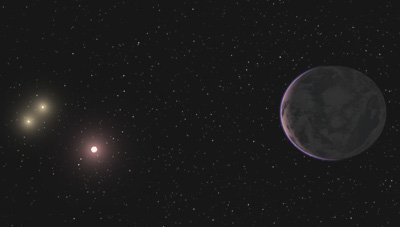Science News
New Neighbors?
February 2, 2012

The headline on Scientific American reads, “Newfound Alien Planet is Best Candidate Yet to Support Life, Scientists Say.”
An international research team, which includes astronomers from UC Santa Cruz, has discovered a new exoplanet in a system about 22 light years from Earth (pretty close, in the scheme of things). The planet, called GJ 667Cc, has an orbital period of 28.15 days and a minimum mass of 4.5 times that of Earth—and it sits smack dab in the parent star’s habitable zone.
Its host star is a member of a triple-star system and has a different makeup than our sun, with a much lower abundance of elements heavier than helium (such as iron, carbon, and silicon). This discovery indicates that potentially habitable planets can occur in a greater variety of environments than previously believed.
The new planet receives 90 percent of the light that Earth receives. However, because most of its incoming light is in infrared wavelengths, the researchers speculate that the planet absorbs a higher percentage of this incoming energy. When both these effects are taken into account, the planet is expected to absorb about the same amount of energy from its star that the Earth absorbs from the sun.
The researchers used public data from the European Southern Observatory and analyzed it with a novel data-analysis method. They also incorporated new measurements from the W. M. Keck Observatory’s High Resolution Echelle Spectrograph and the new Carnegie Planet Finder Spectrograph at the Magellan II Telescope. Their planet-finding technique involved measuring the small wobbles in the star’s motion caused by the gravitational tug of a planet.
The team found that the system might also contain a giant planet and an additional super-Earth with an orbital period of 75 days. However, further observations are needed to confirm these two possibilities.
“This was expected to be a rather unlikely star to host planets. Yet there they are, around a very nearby, metal-poor example of the most common type of star in our galaxy,” says Steven Vogt, a professor of astronomy and astrophysics at UCSC. “The detection of this planet, this nearby and this soon, implies that our galaxy must be teeming with billions of potentially habitable rocky planets.”
“This planet is the new best candidate to support liquid water and, perhaps, life as we know it,” according to team lead Guillem Anglada-Escudé of the Carnegie Institution for Science.
The finding is published in Astrophysical Journal Letters.
Image: Guillem Anglada-Escudé, Carnegie Institution